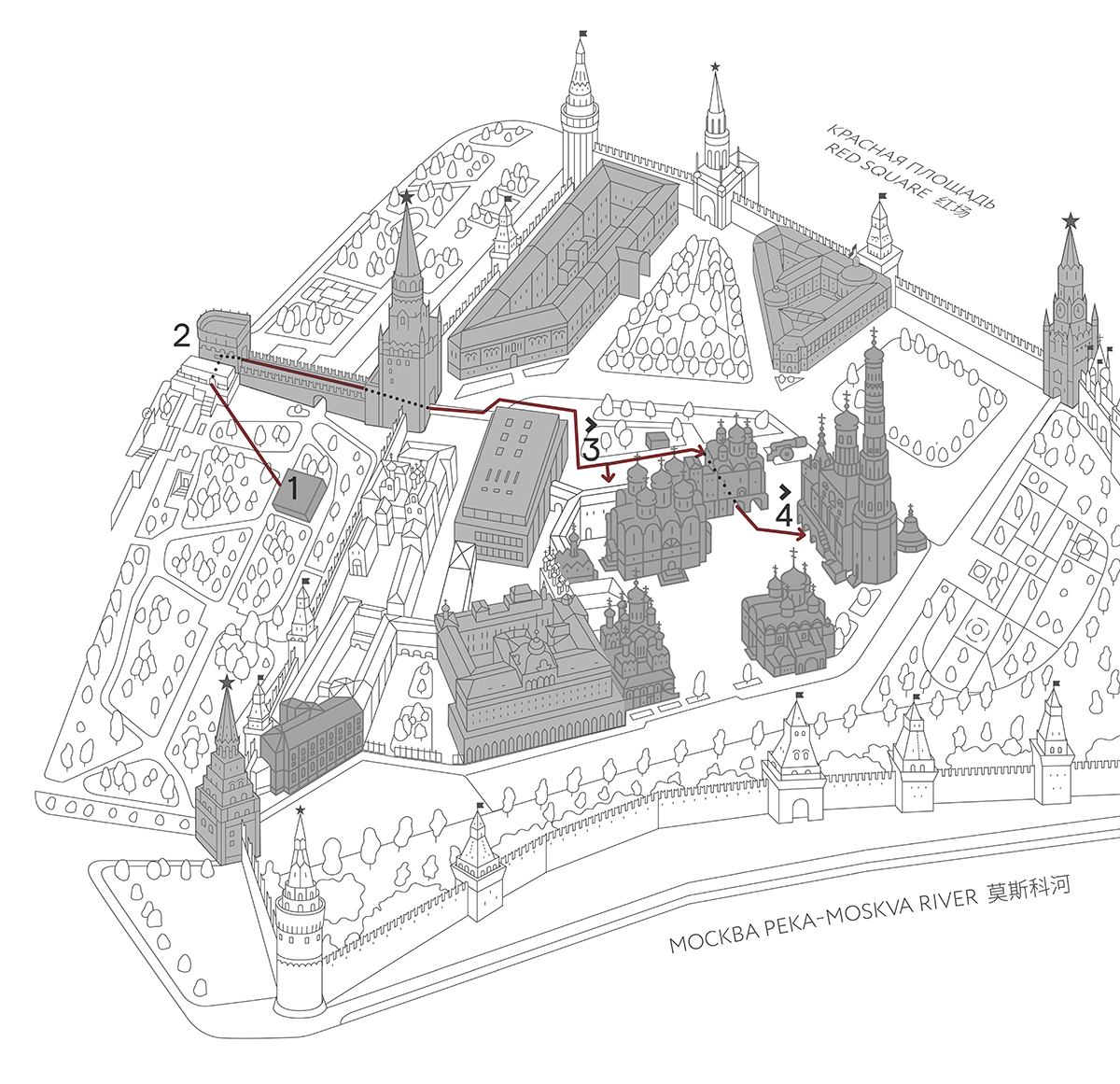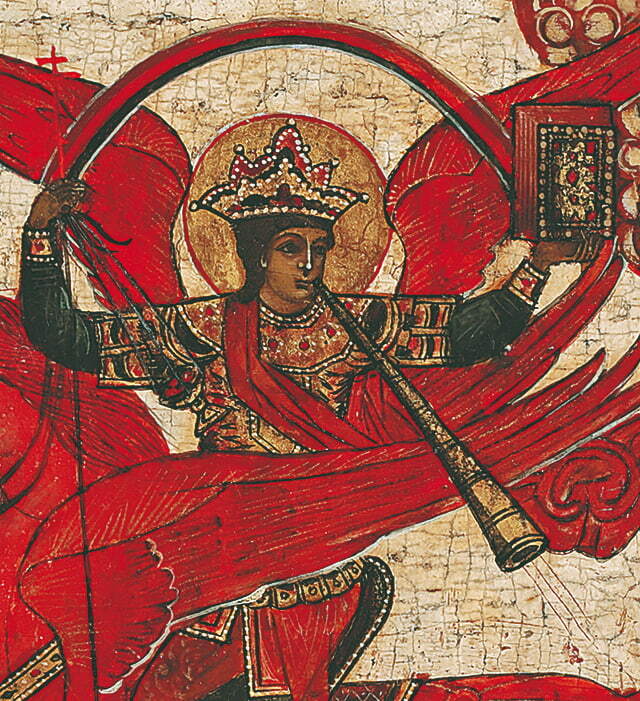
17 march . . . 20 august 2023
1
exhibition hall of the
Patriarch’s Palace
Patriarch’s Palace
2
exhibition hall of the
Assumption Belfry
Assumption Belfry
In the end of the 10th century, Russia discovered its new faith, which gave the Eastern Slavs writing, stone masonry, the world of fine art and literary wisdom. The Russian lands owe their decisive break with paganism to Saint Vladimir, Prince of Kiev, who received baptism along with his retinue in the Byzantine city of Chersonese (Crimea) in 988. From the very beginning, the Christian faith was inextricably bound to the spiritual witness of warrior-martyrs and pious monarchs. Embracing Christianity, the people of Russia began to embrace a new kind of history, new imagery, and new names, including the names of the glorified pan-Christian warrior-martyrs: Saints George and Demetrius, Theodore Stratelates and Theodore Tyrone, Mercury and Mina, Andrew Stratelates and Nicetas the Expeller, John the Warrior and Varus. The figure of Archangel Michael, the archistrategos (or ‘supreme commander’) of the heavenly host, was surrounded by particular veneration.
The host of early Christian warrior-martyrs was soon joined by uniquely Russian warrior-saints: princes who attained sanctity either through their martyrdom (such as Boris and Gleb, the sons of Saint Vladimir, the Baptizer of
The host of early Christian warrior-martyrs was soon joined by uniquely Russian warrior-saints: princes who attained sanctity either through their martyrdom (such as Boris and Gleb, the sons of Saint Vladimir, the Baptizer of
Russia, Grand Prince Yuri Vsevolodovich of Vladimir, who gave his life fighting the Mongol invasion, and Prince Mikhail of Chernigov, who was martyred in the Golden Horde) or through their pious reign and defense of Orthodox Christendom (such as the renowned Grand Princes Alexander Nevsky and Dmitry Donskoy).
In the end, the heavenly host proved to be a steadfast presence in Russian spiritual life and culture. Infants, at their baptism, would often be given the names and brought under the patronage of the Archangel Michael, the early Christian warrior martyrs, the canonized princes of Russia. The intervention and prayer of Saint Michael and the warrior saints would be sought in times of war and turmoil; parish churches and majestic cathedrals would be built and dedicated in their honour. Russian art is unimaginable without the presence of the holy warriors of Christ: their images found their incarnation in icons and frescoes, in carvings ranging from precious pectoral pendants to grand-standing church sculptures, wrought of wood and stone, on weaponry forged by the arms of the smiths and in embroidery, stitched by the fair hands of maidens.
In the end, the heavenly host proved to be a steadfast presence in Russian spiritual life and culture. Infants, at their baptism, would often be given the names and brought under the patronage of the Archangel Michael, the early Christian warrior martyrs, the canonized princes of Russia. The intervention and prayer of Saint Michael and the warrior saints would be sought in times of war and turmoil; parish churches and majestic cathedrals would be built and dedicated in their honour. Russian art is unimaginable without the presence of the holy warriors of Christ: their images found their incarnation in icons and frescoes, in carvings ranging from precious pectoral pendants to grand-standing church sculptures, wrought of wood and stone, on weaponry forged by the arms of the smiths and in embroidery, stitched by the fair hands of maidens.
The exhibition unfolds the 1000-year old history of warrior saints in Russian art, from the pre-Mongol period to the 20th century, bringing together over one hundred and thirty masterpieces of iconography, sculpture, secular painting, numismatics, phaleristics, arms and armor, jewellery.
The exposition in the One-pillar Chamber of the Patriarch's Palace includes seven thematic sections dedicated to the Archangel Michael, to the most venerated warrior-martyrs - Saints George, Demetrius of Thessaloniki and Theodore Stratelates, and to the traditions of piety and sanctity found among Russian princes. The exhibition continues in the Assumption Belfry, where it examines various motifs, pertaining to the intercession and appeal to the Heavenly Host and the warrior-saints in the court ceremonial and state symbolism of the Moscow Tsardom and the Russian Empire; thus, the second part of the exhibition brings together weaponry, orders and awards, ceremonial items from the coronation of the last Tsar – Nicholas II, icons of warrior-saints created in the 17th-19th centuries, banners of the Russian Tsars – preserved in watercolour sketches.
The exhibition ends with artwork the Soviet period, including Pavel Korin’s sketches to his monumental
The exposition in the One-pillar Chamber of the Patriarch's Palace includes seven thematic sections dedicated to the Archangel Michael, to the most venerated warrior-martyrs - Saints George, Demetrius of Thessaloniki and Theodore Stratelates, and to the traditions of piety and sanctity found among Russian princes. The exhibition continues in the Assumption Belfry, where it examines various motifs, pertaining to the intercession and appeal to the Heavenly Host and the warrior-saints in the court ceremonial and state symbolism of the Moscow Tsardom and the Russian Empire; thus, the second part of the exhibition brings together weaponry, orders and awards, ceremonial items from the coronation of the last Tsar – Nicholas II, icons of warrior-saints created in the 17th-19th centuries, banners of the Russian Tsars – preserved in watercolour sketches.
The exhibition ends with artwork the Soviet period, including Pavel Korin’s sketches to his monumental
triptychs and mosaics, dedicated to Alexander Nevsky and Dmitry Donskoy. These works clearly demonstrate that in all periods of Russian history, down to our day, the imagery and feats of the warrior-saints remain intact as timeless, immortal symbols providing solace, inspiration and hope.
This exhibition is one of the largest in the history of Russian museums, a project that brings together both well-known masterpieces and rarely seen artifacts, as well as several works of art that will be shown to the public for the very first time. The unique exhibits include the icon of the Archangel Michael (c. 1400) from the Archangel Cathedral of the Moscow Kremlin; a pair gonfalons with the images of the archangels dating back to the 12th-13th centuries – the oldest surviving works of Medieval Russian embroidery; unique examples of Russian church sculpture of the 14th-17th centuries; various depictions of the Great Martyr and Victory-bearer George, including one of the two oldest pre-Mongolian icons, now kept in the Moscow Kremlin's Dormition Cathedral. A carved image of St George and the Dragon, made by a European master and kept in the Dormition Cathedral since the 17th century will be put on display for the first time in its history.
This exhibition is one of the largest in the history of Russian museums, a project that brings together both well-known masterpieces and rarely seen artifacts, as well as several works of art that will be shown to the public for the very first time. The unique exhibits include the icon of the Archangel Michael (c. 1400) from the Archangel Cathedral of the Moscow Kremlin; a pair gonfalons with the images of the archangels dating back to the 12th-13th centuries – the oldest surviving works of Medieval Russian embroidery; unique examples of Russian church sculpture of the 14th-17th centuries; various depictions of the Great Martyr and Victory-bearer George, including one of the two oldest pre-Mongolian icons, now kept in the Moscow Kremlin's Dormition Cathedral. A carved image of St George and the Dragon, made by a European master and kept in the Dormition Cathedral since the 17th century will be put on display for the first time in its history.
In the end of the 10th century, Russia discovered its new faith, which gave the Eastern Slavs writing, stone masonry, the world of fine art and literary wisdom. The Russian lands owe their decisive break with paganism to Saint Vladimir, Prince of Kiev, who received baptism along with his retinue in the Byzantine city of Chersonese (Crimea) in 988. From the very beginning, the Christian faith was inextricably bound to the spiritual witness of warrior-martyrs and pious monarchs. Embracing Christianity, the people of Russia began to embrace a new kind of history, new imagery, and new names, including the names of the glorified pan-Christian warrior-martyrs: Saints George and Demetrius, Theodore Stratelates and Theodore Tyrone, Mercury and Mina, Andrew Stratelates and Nicetas the Expeller, John the Warrior and Varus. The figure of Archangel Michael, the archistrategos (or ‘supreme commander’) of the heavenly host, was surrounded by particular veneration.
GALLERY . . .
sponsor of the exhibition

. . .BOOKS AND SOUVENIRS

The catalogue is dedicated to the images of warrior-saints in Russian and Byzantium art. It brings together over one hundred and thirty masterpieces created between the 11th and 20th centuries, from the collections of the Moscow Kremlin Museums, the State Hermitage, the State Tretyakov Gallery, the State Historical Museum, the Mikhail Abramov Museum of the Russian Icon. These are icons, sculpture, armoury and arms, orders and awards, old banners and their watercolour drawings, made in the 19th century, as well as Mikhail Nesterov’s and Pavel Korin’s sketches, dedicated to the great Russian commanders Alexander Nevsky and Dmitry Donskoy.
The brightly illustrated publication is aimed at a wide range of readers.
The brightly illustrated publication is aimed at a wide range of readers.
BOOKS AND SOUVENIRS

The catalogue is dedicated to the images of warrior-saints in Russian and Byzantium art. It brings together over one hundred and thirty masterpieces created between the 11th and 20th centuries, from the collections of the Moscow Kremlin Museums, the State Hermitage, the State Tretyakov Gallery, the State Historical Museum, the Mikhail Abramov Museum of the Russian Icon. These are icons, sculpture, armoury and arms, orders and awards, old banners and their watercolour drawings, made in the 19th century, as well as Mikhail Nesterov’s and Pavel Korin’s sketches, dedicated to the great Russian commanders Alexander Nevsky and Dmitry Donskoy.
The brightly illustrated publication is aimed at a wide range of readers.
The brightly illustrated publication is aimed at a wide range of readers.
. . . VISIT US
09:30 to 18:00
Ticket office: 09:00 to 17:00
Day off ‒ Thursday
Ticket office: 09:00 to 17:00
Day off ‒ Thursday
Left luggage office:
9:00 to 18:30
9:00 to 18:30
Guided tours office:
+7 (495) 695-41-46
+7 (495) 697-03-49
+7 (495) 695-41-46
+7 (495) 697-03-49
Exhibition tickets. Available online, at the museum ticket office and via touch-sensitive terminals.
The admission is organized in sessions every half hour from 10:00 to 16:00.
The admission is organized in sessions every half hour from 10:00 to 16:00.
tickets priceS
OPENNING HOURS
GETTING HERE
09:30 to 18:00
Ticket office: 09:00 to 17:00
Day off ‒ Thursday
Ticket office: 09:00 to 17:00
Day off ‒ Thursday
Left luggage office:
9:00 to 18:30
9:00 to 18:30
Guided tours office:
+7 (495) 695-41-46
+7 (495) 697-03-49
+7 (495) 695-41-46
+7 (495) 697-03-49

Content Oriented Web
Make great presentations, longreads, and landing pages, as well as photo stories, blogs, lookbooks, and all other kinds of content oriented projects.
Exhibition tickets. Available online, at the museum ticket office and via touch-sensitive terminals.
The admission is organized in sessions every half hour from 10:00 to 16:00.
The admission is organized in sessions every half hour from 10:00 to 16:00.
TICKETS PRICE

Content Oriented Web
Make great presentations, longreads, and landing pages, as well as photo stories, blogs, lookbooks, and all other kinds of content oriented projects.
1.Ticket and Guided Tours Office in the Alexander Garden
2.Kutafiya Tower

Start here
3.Exhibition Hall of the Patriarch’s Palace
Continue HERE
4.Exhibition Hall of the Assumption Belfry
1.Ticket and Guided Tours Office in the Alexander Garden
2.Kutafiya Tower

Start here
3.Exhibition Hall of the Patriarch’s Palace
Continue HERE
4.Exhibition Hall of the Assumption Belfry









































